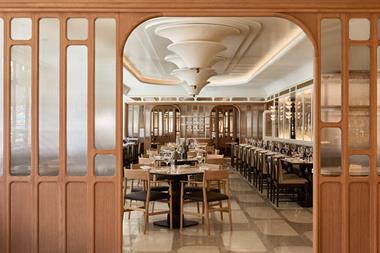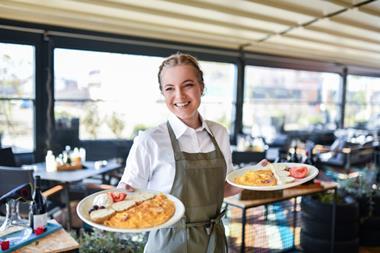The supposed death of the high street has been a common debate over the past few years but what is being done to bring our town centres back to life, and how does F&B fit into this? Simon Stenning gives his view.
While casual dining has experienced well-documented travails in the past couple of years, given the downturn in consumer confidence and economic challenges, the UK retail sector has had it even tougher.
While the likes of Toys ‘R Us, Maplin, Poundworld and BHS may have had their time, their disappearance from the high street, along with the store reductions of House of Fraser, M&S and New Look, have had a profound impact on town centres.
The rise of consumer shopping online together with business rates, National Minimum Wage increases and generally increasing costs from all sides, mean that the high street is looking very different now, and will continue to change its nature in the future.
If we can buy everything online now, what is the purpose of shops? What role do shopping centres play in our lives if we don’t need to go to them to buy things? These are worrying questions because, of course, F&B has played a large part in the development of shopping centres over the last few years, certainly since Westfield built Stratford with 70 out of 200 units being F&B, and Trinity Kitchen was built in Leeds as a focal point for F&B in a city centre.
A recent visit to the Intu Merry Hill shopping centre showed the role that F&B plays as it is packed with cafes and fast food outlets, and (albeit during the summer holidays) was crammed with a wide cross-section of consumers, although few seemed to be sporting shopping bags.
As attractive as it may seem, simply rushing to replace retail units with F&B isn’t the answer, as we’ve found recently. Retail is going to have to change, and while F&B will play a significant part in that, other reasons will need to be created for consumers to want to go onto the high street or into shopping centres.
On a recent trip to California, I experienced a digitally native, vertically integrated retail concept (their words!), called B8ta which is providing a new retail experience for consumers of all ages and demographics. B8ta creates an environment designed for consumers to discover, try and buy new innovations. Products are generally tech-focused, but included a fat-tyred electric bike, a smart garden plant system, a mediating head band, and so on.
Most importantly, the B8ta environment allows consumers to experience things rather than simply look or read about them online, and that is a critical development. F&B is another way of allowing consumers to gain experiences, and this is where the service and theatre elements of restaurants need to really shine, as these are experiences that can’t be replicated at home, even with delivery.
Some retail developments that have targeted a younger consumer to keep them engaged with the high street, have been in the active wear sector. Recognising that digitally native millennials and Gen Z consumers are seeking the more experiential shopping experience, some retail brands are providing interactive showrooms and displays that allow for a complete experience such as the Extreme Weather room at Woolrich’s store in Milan, or Dish & Duer in Vancouver, who sell performance denim jeans in a store featuring a playground of hammocks, ladders and a treehouse, allowing customers to really experience how their jeans will feel when being used actively. There are many retail developments utilising technology and providing immersive experiences, but consumers’ expectations keep getting higher.
Other experiential concepts will help to draw consumers onto the high street. We’ve seen the success of competitive socialising, with the development of Swingers, Bounce, Flight Club etc, but these have generally been built around evening occasions, and with a strong drink focus. Puttshack does change this by locating in a shopping centre which helps to maximise and further the appeal of the destination, while drawing from all consumer occasions whether they be retail, leisure or F&B.
Another development seen recently, which can provide a new impetus for consumers to visit the high street, is the Escape Hunt business. Led by Richard Harpham (ex-MD of Harris & Hoole and strategy director at Pret), this AIM-listed global business is taking old retail sites, or old office space above retail sites and creating the next wave of experiences. While the escape room concept it not new, Escape Hunt has taken it to the next level with sophisticated technology and theatrical set design and creative stories; a notable announcement recently of a partnership with the BBC to launch Dr Who-themed rooms will elevate the concept to a significant level above any competitors.
I’m pleased to say that on a recent visit to Escape Hunt in Birmingham, I managed to secure my escape with seconds to spare!
So, the future of the high street will be made up of experiential businesses, like Escape Hunt, a new style of retail like B8ta, and of course F&B, as consumers seek both the social and the experiential. Even the retail side will change, as services take the place of normal shops. Nail bars and salons have traditionally taken tertiary retail space, as they are small businesses with poor covenants seeking lower rents, but could we see them develop into primary retail spaces?
Will we see tattoo parlours, which have traditionally been back street staples, moving into prime retail space, as tattoos become more prevalent and accepted? This really would be a major change for the high street, and yet tattoos are an element of fashion that ought to have their place in the same way that clothes shops do.
Developers and landlords are going to have to take a new approach to traditional retail spaces and think differently about what is going to draw consumers out from their homes. In hotter climes, shopping centres are a place of comfort, as less affluent consumers don’t have the luxury of air-conditioning in their own homes, but in the UK, despite this summer’s freak heatwave, this isn’t so important. We are developing a new way of living and working however, and the flexible office space of the likes of We Work, or the pared back gyms such as Pure Gym, are another development that will bring more people into traditional retail spaces.
The generational changes that we have seen with millennials and now with Gen Z, will mean that expectations of living, working and leisure time are demanding different things from retailers, employers and leisure providers, but these can be really positive for the F&B sector. Contract caterers are still evolving and trying to move away from the traditional workplace canteen, and the threat of new workspaces like We Work mean that evolution is more critical. We Work’s mission statement is to ‘make a life, not just a living’, and having craft beer on draft and micro-roasted coffee for example, shows recognition of changing consumer demands.
MCA have talked about the third space being reclaimed by pubs, with the likes of Loungers, however there need to be further developments in this, and hybrid models that combine coffee-shops, pubs, personal services, the experiential, and casual dining are going to be the future.
So, there is going to be a future for the high street, it just isn’t going to look like it does now.
Precis
The future’s bright, but it’s not retail
The supposed death of the high street has been a common debate over the past few years but what is being done to bring our town centres back to life, and how does F&B fit into this? Simon Stenning gives his view.











































